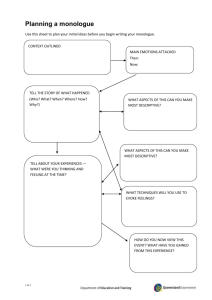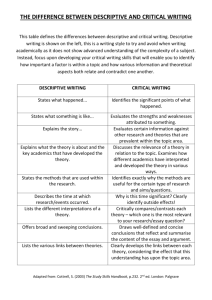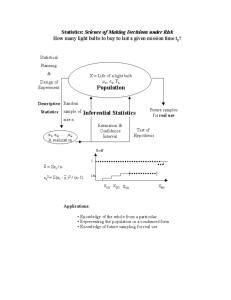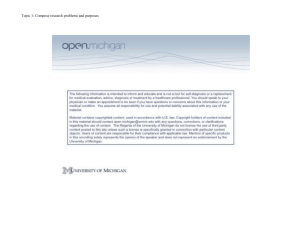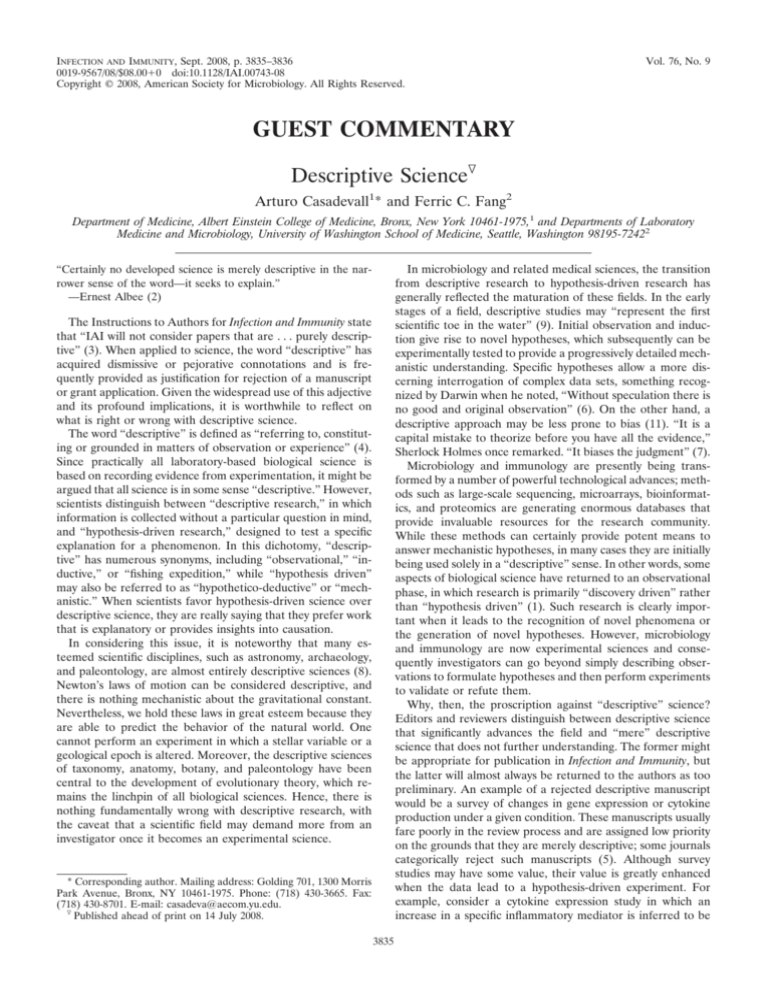
INFECTION AND IMMUNITY, Sept. 2008, p. 3835–3836
0019-9567/08/$08.00⫹0 doi:10.1128/IAI.00743-08
Copyright © 2008, American Society for Microbiology. All Rights Reserved.
Vol. 76, No. 9
GUEST COMMENTARY
Descriptive Science䌤
Arturo Casadevall1* and Ferric C. Fang2
Department of Medicine, Albert Einstein College of Medicine, Bronx, New York 10461-1975,1 and Departments of Laboratory
Medicine and Microbiology, University of Washington School of Medicine, Seattle, Washington 98195-72422
In microbiology and related medical sciences, the transition
from descriptive research to hypothesis-driven research has
generally reflected the maturation of these fields. In the early
stages of a field, descriptive studies may “represent the first
scientific toe in the water” (9). Initial observation and induction give rise to novel hypotheses, which subsequently can be
experimentally tested to provide a progressively detailed mechanistic understanding. Specific hypotheses allow a more discerning interrogation of complex data sets, something recognized by Darwin when he noted, “Without speculation there is
no good and original observation” (6). On the other hand, a
descriptive approach may be less prone to bias (11). “It is a
capital mistake to theorize before you have all the evidence,”
Sherlock Holmes once remarked. “It biases the judgment” (7).
Microbiology and immunology are presently being transformed by a number of powerful technological advances; methods such as large-scale sequencing, microarrays, bioinformatics, and proteomics are generating enormous databases that
provide invaluable resources for the research community.
While these methods can certainly provide potent means to
answer mechanistic hypotheses, in many cases they are initially
being used solely in a “descriptive” sense. In other words, some
aspects of biological science have returned to an observational
phase, in which research is primarily “discovery driven” rather
than “hypothesis driven” (1). Such research is clearly important when it leads to the recognition of novel phenomena or
the generation of novel hypotheses. However, microbiology
and immunology are now experimental sciences and consequently investigators can go beyond simply describing observations to formulate hypotheses and then perform experiments
to validate or refute them.
Why, then, the proscription against “descriptive” science?
Editors and reviewers distinguish between descriptive science
that significantly advances the field and “mere” descriptive
science that does not further understanding. The former might
be appropriate for publication in Infection and Immunity, but
the latter will almost always be returned to the authors as too
preliminary. An example of a rejected descriptive manuscript
would be a survey of changes in gene expression or cytokine
production under a given condition. These manuscripts usually
fare poorly in the review process and are assigned low priority
on the grounds that they are merely descriptive; some journals
categorically reject such manuscripts (5). Although survey
studies may have some value, their value is greatly enhanced
when the data lead to a hypothesis-driven experiment. For
example, consider a cytokine expression study in which an
increase in a specific inflammatory mediator is inferred to be
“Certainly no developed science is merely descriptive in the narrower sense of the word—it seeks to explain.”
—Ernest Albee (2)
The Instructions to Authors for Infection and Immunity state
that “IAI will not consider papers that are . . . purely descriptive” (3). When applied to science, the word “descriptive” has
acquired dismissive or pejorative connotations and is frequently provided as justification for rejection of a manuscript
or grant application. Given the widespread use of this adjective
and its profound implications, it is worthwhile to reflect on
what is right or wrong with descriptive science.
The word “descriptive” is defined as “referring to, constituting or grounded in matters of observation or experience” (4).
Since practically all laboratory-based biological science is
based on recording evidence from experimentation, it might be
argued that all science is in some sense “descriptive.” However,
scientists distinguish between “descriptive research,” in which
information is collected without a particular question in mind,
and “hypothesis-driven research,” designed to test a specific
explanation for a phenomenon. In this dichotomy, “descriptive” has numerous synonyms, including “observational,” “inductive,” or “fishing expedition,” while “hypothesis driven”
may also be referred to as “hypothetico-deductive” or “mechanistic.” When scientists favor hypothesis-driven science over
descriptive science, they are really saying that they prefer work
that is explanatory or provides insights into causation.
In considering this issue, it is noteworthy that many esteemed scientific disciplines, such as astronomy, archaeology,
and paleontology, are almost entirely descriptive sciences (8).
Newton’s laws of motion can be considered descriptive, and
there is nothing mechanistic about the gravitational constant.
Nevertheless, we hold these laws in great esteem because they
are able to predict the behavior of the natural world. One
cannot perform an experiment in which a stellar variable or a
geological epoch is altered. Moreover, the descriptive sciences
of taxonomy, anatomy, botany, and paleontology have been
central to the development of evolutionary theory, which remains the linchpin of all biological sciences. Hence, there is
nothing fundamentally wrong with descriptive research, with
the caveat that a scientific field may demand more from an
investigator once it becomes an experimental science.
* Corresponding author. Mailing address: Golding 701, 1300 Morris
Park Avenue, Bronx, NY 10461-1975. Phone: (718) 430-3665. Fax:
(718) 430-8701. E-mail: casadeva@aecom.yu.edu.
䌤
Published ahead of print on 14 July 2008.
3835
3836
GUEST COMMENTARY
important because its expression changes during infection.
Such an inference cannot be made on correlation alone, since
correlation does not necessarily imply a causal relationship.
The study might be labeled “descriptive” and assigned low
priority. On the other hand, imagine the same study in which
the investigators use the initial data to perform a specific experiment to establish that blocking the cytokine has a certain
effect while increasing expression of the cytokine has the opposite effect. By manipulating the system, the investigators
transform their study from merely descriptive to hypothesis
driven. Hence, the problem is not that the study is descriptive
per se but rather that there is a preference for studies that
provide novel mechanistic insights.
When a manuscript is rejected by Infection and Immunity for
being “merely descriptive,” the reviewer is essentially saying
that the work has not revealed novel phenomena, has failed to
generate interesting novel hypotheses, or has failed to adequately follow up such hypotheses with further experimentation. The most common reason for a paper to be assessed as
“merely descriptive” is that more in-depth investigation is required. A reviewer who recommends that a paper be rejected
because it is “merely descriptive” can provide a great service to
the authors by clearly and unambiguously explaining the additional studies required for the paper to become more significant and therefore more interesting.
Descriptive observations play a vital role in scientific
progress, particularly during the initial explorations made posEditor: J. B. Bliska
INFECT. IMMUN.
sible by technological breakthroughs. At its best, descriptive
research can illuminate novel phenomena or give rise to novel
hypotheses that can in turn be examined by hypothesis-driven
research. However, descriptive research by itself is seldom
conclusive. Thus, descriptive and hypothesis-driven research
should be seen as complementary and iterative (10). Observation, description, and the formulation and testing of novel
hypotheses are all essential to scientific progress. The value of
combining these elements is almost indescribable.
REFERENCES
1. Aebersold, R., L. E. Hood, and J. D. Watts. 2000. Equipping scientists for the
new biology. Nat. Biotechnol. 18:359.
2. Albee, E. 1907. Descriptive and normative sciences. Philos. Rev. 16:40–49.
3. American Society for Microbiology. 2008. Instructions to authors. Infect.
Immun. 76:1–20.
4. Anonymous. 2008. Merriam-Webster online dictionary. http://www.merriam
-webster.com/dictionary/descriptive.
5. Bassler, B., S. Bell, A. Cowman, B. Goldman, D. Holden, V. Miller, T.
Pugsley, and B. Simons. 2004. Editorial policy on genome-scale analyses.
Mol. Microbiol. 52:311–312.
6. Darwin, C., F. Burkhardt (ed.), and S. Smith (ed.). 1985. The correspondence of Charles Darwin. Cambridge University Press, Cambridge, United
Kingdom.
7. Doyle, A. C. 1986. A study in scarlet. Bantam, New York, NY.
8. Grimaldi, D. A., and M. S. Engel. 2008. Why descriptive science still matters.
Bioscience 57:646–647.
9. Grimes, D. A., and K. F. Schulz. 2002. Descriptive studies: what they can and
cannot do. Lancet 359:145–149.
10. Kell, D. B., and S. G. Oliver. 2004. Here is the evidence, now what is the
hypothesis? The complementary roles of inductive and hypothesis-driven
science in the post-genomic era. Bioessays 26:99–105.
11. Marincola, F. M. 2007. In support of descriptive studies; relevance to translational research. J. Translat. Med. 5:21.


